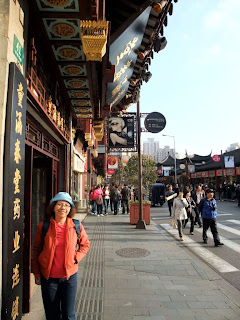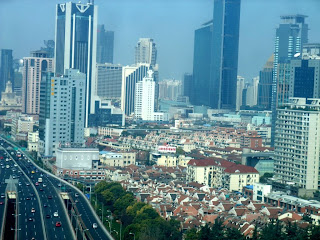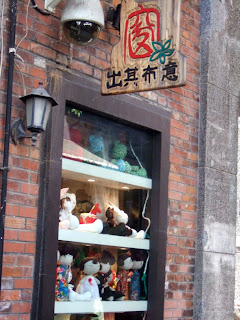
Shanghai, sits at the mouth of Yangtze River in Jiangsu Province, east of China, is one of the most developed and largest city in the world. Shanghai was a village during Song Dynasty, 1000 years ago but grew amazingly after opened to foreign trade in 1842 by Treaty of Nanking. Since 1930's the city was a multinational hub of finance and business in the far east. Though there is a saying said that Shanghai is the heaven for the rich and hell for poor, it is still an up-tempo city that attracts most of the Chinese people from all corners to flock in either to look for an opportunity, to seek for job, to study, to start a career or to round up a dream. Out of its 23 million population, 9 million is the floating migrants. Shanghai has very rich collection of buildings and structures of various architectural styles and despite of its rampant development, the old city still retains some buildings of a traditional style. Shanghai is a fascinating great city where old meets new and west meets east and, surprisingly it is a city of safety.


Shanghai Old Street (上海老街)is the historic Chinese area of Shanghai where many of the old wooden architecture of ancient Shanghai buildings were very well preserved.


Laojie located in Nanshi District at the home of Yu Garden and City God Temple, attracting crowds of tourists and visitors from places all over the world.


This might be the right place to look for China-made items in Shanghai like jade piece or jewelery items, trinkets, local handicrafts or even antique but to have worthy goodies, must be lucky and smart with good bargaining technique.



Looking at those interesting items, nobody would be in doubt why Nanshi Shopping District was sometimes known as "Kingdom of Shanghai's Arts and Crafts.



The wooden ancient jewelery boxes, porcelain cutlery, and tea sets though were not exactly antique but its really attractive.


Attractive souvenirs sold in elaborately decorated shops as well as small roadside stalls.



Chinese Tea House at Old Street and the 4-storey restaurant at the corner of YuYuan Commercial area indicated great contrast in style of Chinese construction in different period. The new commercial lots at the end of Old Street indicated another style.



City God Temple (Cheng Huang Miao) is a Taoist Temple original built in 1403. The current site at the Old Town Bazaar, near Yu Garden was constructed in 1990 with Ming's Emperor Hongwu's likeness as The Town God at the rear hall. The temple was closed after 4.30 pm



An interesting place to spend an evening. Spend rmb5.00 and experience the old jokes from hand operated movie box which was one of the oldest entertainment practiced 500 yrs in olden China, or follow crowd of youngsters queue up for varieties of Shanghai snacks.


It was really a great experience to stroll down the extraordinary bustling lane to enjoy a Shanghai feel.



The famous Shanghai Garden Yu Yuan and its surrounded bazaar are the place most visitors would not want to miss in Shanghai.


Outside the main street, are the ancient Chinese architectural buildings with unique tilt at the roofs while circle inside are famous old shops. "He Fung Lo" is the largest eatery within the area with more than 30 food stalls offering all sorts of local foods and drinks.



"Hua Bao Lao" , "Na Xiang" Steam bun Restaurants, and "Chopsticks" Shops are all traditional old shops with hundred and hundred years of history inside Yuyuan Bazaar.


Every inch of the beautifully decorated ancient architectural ziz-zag bridge above the water of Yuyuan Garden, were filled with foot-sprints.


Mid Lake Pavilion Cafeteria situated on the central surface of the clear pond water of Yuyuan was a famous drinking tea restaurant for decades. Tourists were patient for hours queue just to experience a tea drinking atmosphere of those rich people in the olden days. Imagine that you were seated near the window, served with a cup of aromatic Chinese tea, surrounded in such a scenic atmosphere ........hmmmm.


Many celebrities came here to drink tea. It offers different tea at different prices from rmb 100 to few hundreds and served customers tea with small rice dumpling or melon seeds.


Chinese architecture were certainly part of the main attraction inside this large retail and entertainment district but what we admired most were those signboards and the names they used for their shops.




Not too far away from the main arch gate are the two giants old history jewelery: First Gold Smith and Old FengXiang Jewelery. The two old buildings are facing each other along the main street


The red signboard of MacDonald Fast Food at a traditional Chinese building along the main street, looks attractive and outstanding.m1


Within the large pedestrian compound that mostly dedicated to retails stalls and restaurants appeared two huge black Chinese words on a white base at a beautiful building: Pharmacy.


These are the newly decorated small shops supplying all sorts of Chinese products mostly attires and shoes ! They have uniform Chinese calligraphy and style in signboards.




The entrance arch gate of Cheng Huang Miao Street and Yuyuan Bazaar stands upright in the midst of high-rise buildings.


Nanjing East Road shopping streets is considered the longest shopping district in the world. It is 6 km away from The Bund and extends to up-market area at Xintiandi on the west end.


It is also one of the world busiest shopping street, attracting millions of visitor yearly.






Eastern side of the street features a pedestrian mall with city oldest retail outlets and plenty of local specialty shops


Nanjing East Road is the main and popular shopping district in Shanghai besides Cheng Huang Miao and Yuyuan Bazaar .



Mass of new high rise development in Pudong across Huangpu River.


Check in from this service center and get ready to board from this dock. There are more than 10 docks at this area.


A ticket of Rmy100.00 for an hour night cruise at Huangpu River was value for money as the beautiful Shanghai Night Scene was completely exposed under your eyelids for 60 minutes.


Huangpu River Night Cruise was the best way to admire Shanghai Night. The best hour to board is after 6 pm when the sky started to dark


With buildings lighting turning on, Shanghai becomes alive. It was entirely not the same look from day hours.




Shanghai at night showed a total different glamor of the city, so beautiful.


Each visit, we notified its different. Each year, 5-6 million visitors landed. No Joke!


Oriental Pearl Tower is a significant landmark of Shanghai. With a height of 263 meter, it is now still the tallest tale-communication tower in Asia.




Shanghai is basically divided into two main territories. To the west side of Huangpu River is the old Shanghai Puxi and across the river to the east is Pudong, new developed area. Pudong's Oriental Pearl Tower with two giant spheres and five supporting legs appeared a different kind of beauty in day and at night.



These are some of the decorated cruises, blinking and glittering in colorful neon-light on Huangpu River as if river floats parade.


Shanghai has one of the richest collection of Art Deco Building in the world. The buildings at Puxi glittering in gold at night along the broad way at The Bund.


Bird views from Observatory floor of Oriental Pearl Tower. The Colonial riverside of old Shanghai has dozens of historical buildings like foreign banks and trading houses lining along Huangpu River.



The heavy traffic flow at Puxi, west part of Huangpu River.



Prices of houses in Shanghai have skyrocketed in last year. The rental of a single room 500 sq ft apartment nearby this area fetch a rental of nearly rmb 4 to 5 thousand a month.



The different look of central nine dragons pillar in day and night at the elevated highway. The construction of this large scale development when stated building faced great difficulty in doing the piling. The problem was solved only after the reverent monk from Jade Buddha Temple performing a Buddhist Ceremony on the spot. It was said that there were nine dragons underground and the monk released them and engraved nine dragons on the pillar to symbolize the spot of their territory.




Jingan district continuously inhabited since 3rd century. This part of commercial district at Nanjing West Road extend from center of Jingan to People's Square.



The hustling and bustling Huaihai Street and the layers elevated roads of Yuan An Highway at night .


There were many foreign concessions in designated districts during the turn of 20th century and French Concession is the most notably preserved one in Shanghai. The French Concession which was known as Paris of The East in the past was nearby Luwan and Xuhui Area.



Shanghai has an extensive public transport system largely based on metros, buses and taxis. There are 50,000 taxi, 1000 bus lines and 273 stations for 12 lines of subway and light railway extending to every core urban district as well as neighboring sub-urban areas. Shanghai Metros are the longest in the world cover a total distance of 420 km. There was a record of 7.548 million ridership on 22nd Oct 2010. Fare starts from rmb3.00 for metros and rmb12.00 for the first 3km by taxi while the bus fare started from rmb1.00. It was not too difficult to hop on any one of them as indications at all stations are quite clear and taxi drivers are quite honest. .


The soup bun "xiao long pao" is the most popular food in Shanghai and most of them are done on the spot. There are all kinds of them with various stuffing ingredients including the fried ones. In order to try the special ones, we lined up in long queue and squeezed in a table with the locals. The noodles, dim-sum, Chinese pastries, tit-bits are equivalently in fame with xiao long pao in Wang Jia Sha, a food supplier at Nanjing West Road.



Tiangzifang (田子坊) are The Art Streets transformed and furnished by old houses at the lanes of TaiKang Road. It covers 20,000 sq meter of land, attracting hundreds of artists and designers from all over the world to work and live here.


All shops and stores were traditional residential houses and small scheme road factories blended with western elements renovated in old Shanghai architectural and social behavior.



There are many creative galleries, boutiques, craft shops, art studios, bars and restaurants attracting crowds of yuppies, fashionists, designers as well as expatriates.



It exhibits a mixture of culture, traditional and exotic, commercial yet leisure.



The Shikumen styled stone gate at one of the "long-tang" entrance in Tianzifang.


All restaurants inside "long-tang" offers comfortable, cozy and romantically atmosphere for dining.



Have a cup of coffee in the "long-tang" caferia, you would experience a different feel, a different taste, in a different mood!



You might have to pay higher prices for a meal like rmb30.00 for a pot of Chinese herb tea, but you would certainly enjoy the environment created by most of the restaurants and relax freely with your love ones or friends or carry out your job under the warm sun, without any disturbance for the whole afternoon.




A new art zone, developed from old local residential area, had become a magnet for art galleries.


Some artists just carried out their work, drawing or painting by the road side, mindfully or casually, enjoyed and relaxed.



There are shops supplying old camera, hand-tailoring Chinese cheong-sam and creative gift items.



He finally did not want to walk anymore as he was so relaxing sitting in front of a shop, admiring the shops and watching people strolling down the lane.



Every shop is a piece of art! This is the south east Asian corners, providing arts from Thailand, Vietnam, Indonesia, and many others.



Creative decoration windows and doors from some of the shops.






Artistically planted flowers by some of the shops' owner.





Shanghai hosted 2010 World Expo and attracts 73 millions of visitors. The Expo closed after 184 days fair on 31st October 2010 but due to huge demand from public, China Pavilion reopened for visit on 1st December 2010 for a further of 6 months at an entrance fee of rmb 30.00 before it is converted into a permanent cultural and historical museum in Shanghai.


The striking China Pavilion was named as Crown of East as it looks like an old Emperor' s crown. It stands with a height of 69 meter and cover an area of 160,000 sq meter, which was the largest and tallest display in Shanghai Expo .




Its distinctive roof was made of traditional dougong (brackets), using only columns and crossbeams, which were widely used in construction during Spring Autumn Period (770-467 BC).


During the expo, the number of visitors to this outstanding pavilion was about one million only as it could only accommodate 50,000 people each day. Since it extended on December 01, 2010, people never loose the interest in it. Yesterday's record was 50,000 people. Look at the crowd waiting inside the sheltered courtyard........waiting for 1-2 hours was not a big deal!



"Highlight Replay Witness Success" It was not too late for all visitors. I was glad that I came. We shared their joy.


China spent US$220 million to illustrate its civilization and modern achievement, to show the combination of tradition and modern elements in its architecture, landscaping and exhibits in The expo. It was the most expensive one in World Expo. Only China could make it in this 21st century. His country folks were proud of it so did most of the overseas Chinese.


The most impressive and attractive session was The Scroll " Along The River During The Qingming Festival". This masterpiece of Zhang Zeduan from Song Dynasty was adapted as a large scale of 3D animation, projected onto a massive screen of length 128 meter and 6.5 meter in height. .




And reflecting on the water in front of the screen were some ancient rhymes or pictures.


The animation featured the 1068 figures, boats, vehicles and animals as per the original painting and all Characters moved within landscape and performed their daily tasks.




The interesting part was it also includes a two minutes long night scene of the painting.


Land of Hope representing a world of greenness symbolizing harmony between people, and people with nature in future Chinese Cities. The "Under Same Roof" two minutes multimedia showed an ideal neighborhood of future cities and Super Rice indicated high yield of the future crops. This section emphasized very much on Green Homeland, co-existence of man and nature and a healthy rural-urban linkage in future China.m2




Thematic Exhibition showed the vision and exploration of lower-carbon future in China. The session used four main mathematical operation signs : Add, Contract, multiply and Divide to highlight how China inspired and will develop an innovative solution to meet challenges of urban growth and environment protection. And the 27,000 sq meter rooftop garden demonstrated China modern landscaping technology including its rain harvesting technique.



China Pavilion followed energy-saving initiatives. Its rooftop was applied with 0.36 mega watt solar energy system while at exterior parts, thermal panels and insulating glasses were used.




I cannot thank lemeridian funding service enough and letting people know how grateful I am for all the assistance that you and your team staff have provided and I look forward to recommending friends and family should they need financial advice or assistance @ 1,9% Rate for Business Loan .Via Contact : . lfdsloans@lemeridianfds.com / lfdsloans@outlook.com. WhatsApp...+ 19893943740. Keep up the great work.
ReplyDeleteThanks, Busarakham.